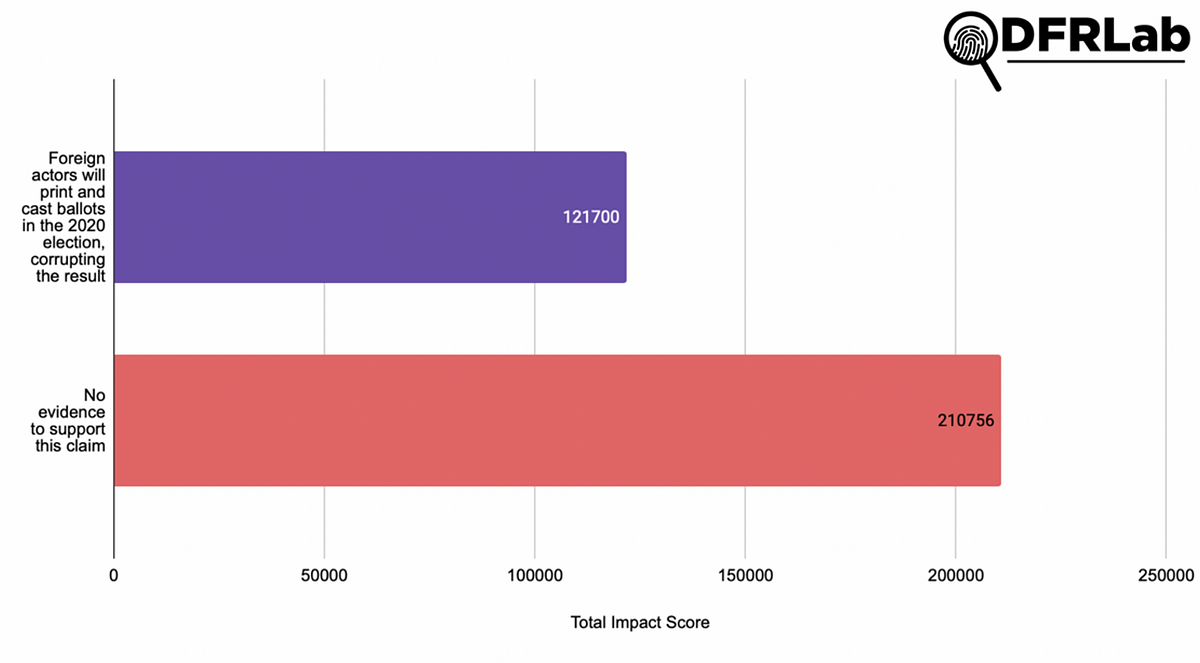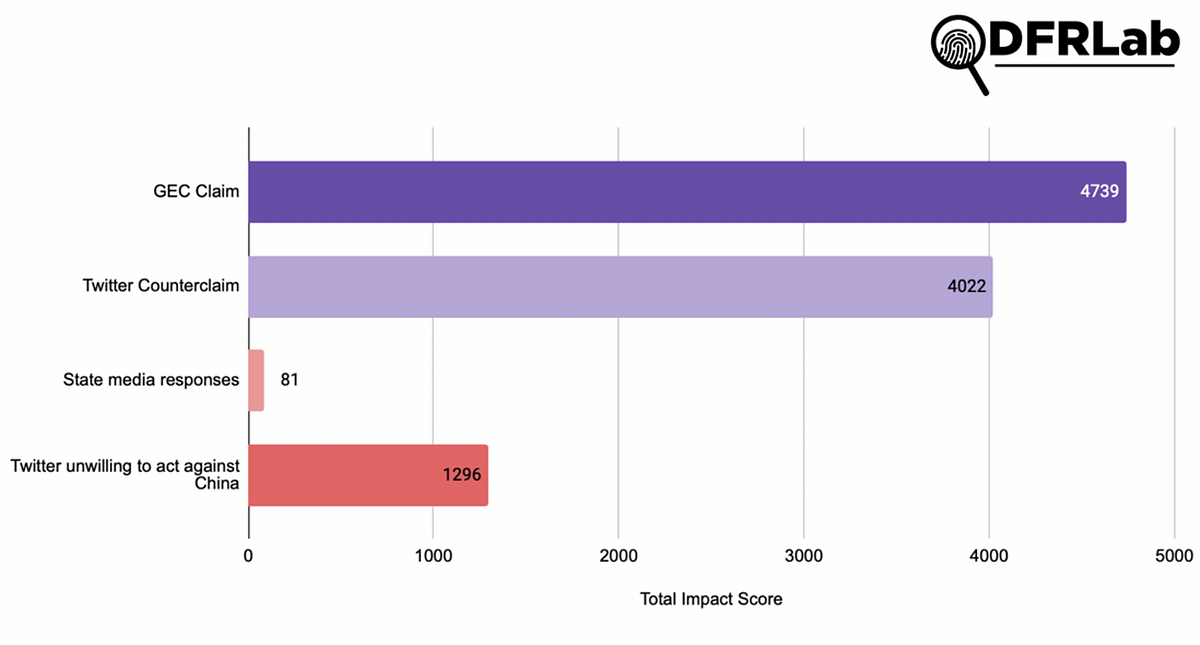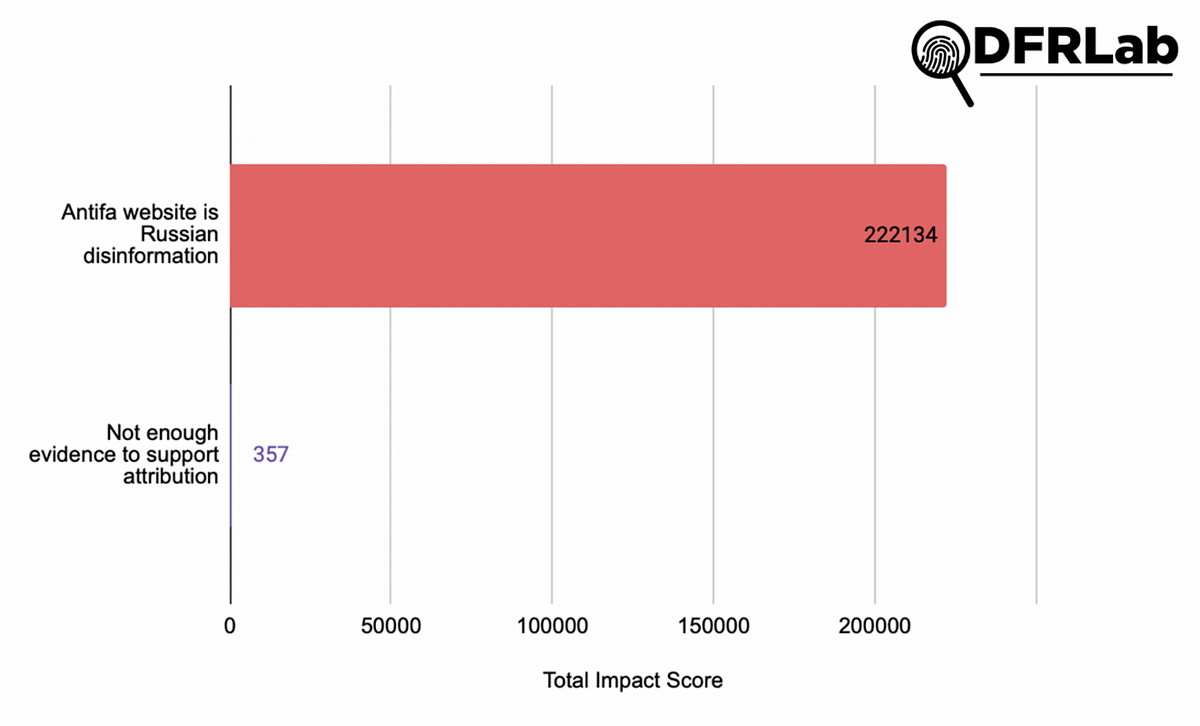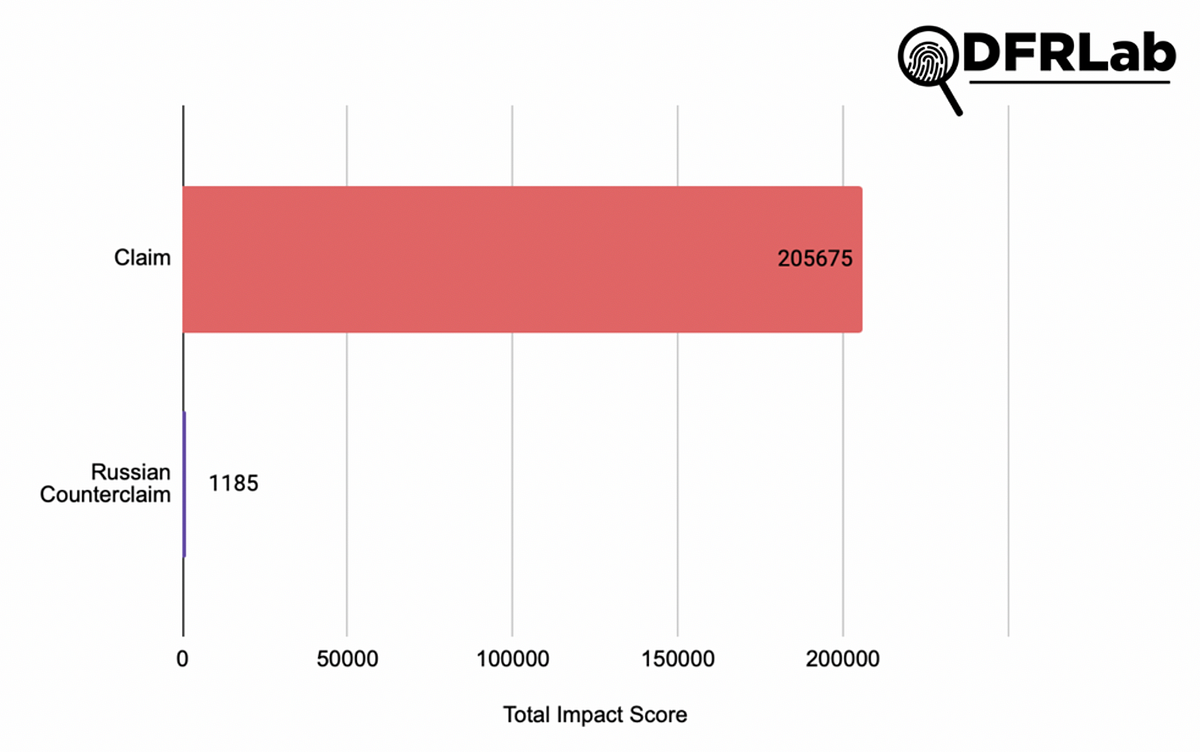Evaluating contradictory foreign interference allegations in the 2020 U.S. election
Information sharing regarding counter-claims of foreign
Evaluating contradictory foreign interference allegations in the 2020 U.S. election

Information sharing regarding counter-claims of foreign interference underscores need for greater evidence and transparency

This article uses the dataset compiled for the DFRLab’s Foreign Interference Attribution Tracker (FIAT), an interactive, open-source database that captures allegations of foreign interference relevant to the 2020 election. The tool consists of six elements that work together in order to tell the complete story of foreign interference allegations in the 2020 U.S. elections and assesses the credibility, bias, evidence, transparency, and impact of each claim. Readers can explore the project by visiting Interference2020.org.
The DFRLab has catalogued 80 allegations of foreign interference in the 2020 U.S. presidential election, a sharp increase from 2016. The volume of foreign interference claims has made it challenging for journalists to summarize and contextualize every instance of foreign interference. It has also more difficult for policymakers to respond and harder for citizens to grasp the scale of the problem. The problem is compounded as these claims vary widely in their evidence and objectivity; sometimes, they even contradict each other. Instances where there are multiple, contradictory claims of foreign interference from traditionally credible actors can be the toughest to assess, as it is more difficult to determine which reporting to treat as more credible.
In our dataset, the DFRLab’s Foreign Interference Attribution Tracker team considered events with contradicting claims or “counter-claims” to be instances where multiple government agencies, technology companies, influential individuals, and media outlets issued diverging allegations of foreign interference to explain the same event. To analyze how each distinct characterization spread through social media, the team sorted media used to determine the total impact score into meta-narratives, and calculated an independent impact score for each contradicting allegation.
The objective of this research is to evaluate the similarities and differences in how each meta-narrative propagated, and to understand which allegations spread further at times when there was a great deal of information sharing but few verifiable facts.
Among the highlights of our analysis:
· Traditional media plays an agenda-setting role on foreign interference allegations, with claims that were endorsed by institutional outlets receiving higher impact scores.
· Contradictory claims between government agencies and social media companies and/or influential individuals arose from conflicting standards and definitions on allegations of foreign interference.
· Disinformant nations utilized foreign interference allegations that lacked strong evidence to highlight social divisions in the United States and the supposed failure of democracy, as well as to garner positive attention at home.
· Allegations lacking in both evidence and transparency resulted in contradictory narratives because they were interpreted based on pre-existing biases, both editorial and political.
Seven case studies: competing claims of foreign interference
Claim: Foreign actors will print and cast millions of mails in ballots in the 2020 election.
On June 22, 2020, President Donald Trump tweeted that unspecified foreign actors would print millions of ballots to rig the election, calling it the “scandal of our times.” Neither the president nor the White House substantiated the allegation. Coverage endorsing the claim accounted for 121,700 engagements with the tweet and largely originated from far-right commentators and blogs, which cited the tweet as evidence of widespread fraud in the 2020 election. The tweet was woven into the QAnon conspiracy theory when Q, the anonymous leader of the conspiratorial movement, built upon the tweet by implying that China would coordinate with select states to print and distribute the ballots. Further, outlets such as MintPress News and RT published the claim to highlight internal division in the U.S. and sow doubt in the 2020 election.
While the original tweet spread virally and with little refutation through online spaces favorable to the president, mainstream coverage offered a credible counter-claim, noting a lack of evidence and disregard for safeguards intended to guarantee the security of the election. Reporting on the counter-claim, which stressed the potential for such unfounded claims to create unnecessary fears, outweighed the coverage that validated it, accounting for 210,759 of the engagements with the allegation.

Claim: Inauthentic Twitter accounts connected to the Chinese government amplified disinformation about COVID-19.
During a press briefing, the State Department’s Global Engagement Center (GEC) claimed that bot networks on Twitter were pushing Chinese government narratives about COVID-19 and that Chinese propaganda appeared to be coordinated with Russian propaganda. When GEC sent Twitter a sample of 5,000 accounts, however, Twitter was unable to verify that the accounts were bots. Many of the accounts belonged to government entities, NGOs, and journalists, Twitter asserted.
Mainstream news coverage of the claim and counter-claim was balanced, with most outlets mentioning both the claim and the counter-claim. Russian and Chinese state media outlets Sputnik and CGTN also presented both narratives, although they described the allegations as an attempt to change the narrative on COVID-19 in a way that would be favorable to the Trump administration. Finally, coverage on some U.S.-oriented sites known for spreading disinformation pushed the idea that Twitter was unwilling to act against China and that this was the motivation for the counter-claim. The original claim and the counter-claim both received over 4,000 views, significantly more than either of the other two narratives.

Claim: “Russian Bots” target Kamala Harris’s campaign on Twitter.
During her campaign for the Democratic presidential nomination, Sen. Kamala Harris said that her campaign was being targeted on Twitter by “Russian bots.” Four days later, CNN reported that it had checked the claim with Twitter, and that a company spokesperson stated that Twitter did not have any evidence of state-backed accounts attacking the campaign. The outlet also reviewed research and assets provided by the campaign which it claimed were demonstrative of foreign interference; the network was unable to corroborate Russian interference based on this evidence. The first print reporting on the allegation contextualized it, noted the use of Russian bots as an inaccurate “catch all term,” and offered valid counter-evidence to dispel the claim of foreign interference. In consequence, subsequent reporting on the event adopted the same narrative.

Claim: Individuals linked to Nicolás Maduro incited violence at protests in Miami following the death of George Floyd.
The White House said it had information that individuals linked to Venezuelan leader Nicolás Maduro incited violence at protests in the United States spurred by George Floyd’s death, following a tweet by Sen. Rick Scott that made the same claim and vowed to protect Floridians from operatives tied to Latin American dictators. The White House offered no evidence for its claim, while Sen. Scott cited a report by Diario Las Américas, a Spanish-language newspaper based in Florida, whose reporting was based on an unsubstantiated blog post by Primer Informe.
In addition to coverage by American news networks, this claim also received wide coverage in Spanish, often citing the Miami Herald’s reporting and contextualizing the claim. Sputnik opportunistically reported on the claim, noting the lack of evidence, and pointing to domestic turmoil in the United States. While most of this coverage mediated the claims of influential individuals, Nicolas Maduro notably commented on the claims, calling them untrue. Maduro’s statement received 55,971 engagements across social media, roughly 20,000 more than the Miami Herald’s initial report. As the allegation lacked credible public evidence, an authoritarian regime was able to leverage it for positive positioning against the U.S. government.

Claim: Antifa.com website is linked to Russia
On August 12, 2020, Yahoo! News published an investigation on the website antifa.com after Chanel Rion, the White House correspondent for the conservative One America News, raised a question on the link between antifa.com and the Biden presidential campaign website. The investigation, which was based on data from Whoisology.com, a domain name ownership archive, indicates that the site was registered in Russia from 2013 to 2019 and then was transferred to Panama in June 2019.
The story gained traction as it claimed to substantiate ongoing Russian interference, an eye-catching topic leading up to the presidential election. But the investigation stands on a shaky foundation, as Mashable and NixIntel pointed out that there is no adequate information to establish the definite link between antifa.com and Russian actors. The attribution was also countered by Russian media, including RT, which took advantage of Yahoo! News’s premature conclusion for its own propaganda use.
However, despite their lack of credibility, the original claims have achieved far more media attention than the counter-claims. In total, the social media impact of the original claim achieved an impact score of 222,134, while the counter-claims by Russian outlets, Mashable, and NixIntel have gained an impact score of 357.

The Russian outlet RT’s English-language coverage, which not only blames the Yahoo! investigation for being premature but further discredits the outlet and its investigation led by Michael Isikoff (who was one of the first journalists to break the story on Steele dossier), received only 29 engagements on social media platforms.

Claim: U.S. Officials are Assessing Russian Attacks on Biden
On January 10, 2020, Bloomberg News published an article on the U.S. intelligence community’s decision to investigate whether Russia was taking advantage of the U.S. presidential election. The concerns of senior intelligence and law enforcement officials follow from known Russian interference in the 2016 presidential election and 2018 midterm election. The news report soon gained plenty of media attention, especially after George Stephanopoulos, the television host from ABC News, referred to the Bloomberg article during his interview with Nancy Pelosi, where she accused Mitch McConnell of being an “accomplice” to Trump in dealing with Russian interference in the electoral system. The total engagement gained by the claim reached 205,675.

However, as the story provides little definitive evidence against Russian interference, it soon received pushback from both right-wing communities within the U.S. and Russian state-sponsored media. The Russian counter-claim, first published by RT, received 1,074 engagements. The article attacks the so-called U.S. “establishment” for finding excuses for Biden’s performance in the campaign season and distorts the narratives to portray Biden and his campaign as the “disinformants” that defame both Russia and President Trump. Moreover, as other media picked up the narrative, two articles also attempted to link the intelligence activities with the partisan complexities and the “deep state” conspiracy theory that spreads rapidly among the far-right communities. However, much like the previous example with a Russian rebuttal on the attribution, the counter-claim received far less engagements than the original claim.
Claim: Websites connected to Russian intelligence are spreading on COVID-19.
The New York Times and AP reported on declassified U.S. intelligence accusing several websites and a think tank of spreading disinformation about COVID-19. This information supported previous investigations by EU Disinfo Lab and cybersecurity firm FireEye. In the U.S. media, the claim was generally accepted. The Russian media, however, put forward several counter-claims. OneWorld accused the U.S. of hypocrisy about free speech. The Strategic Culture Foundation, the think tank, characterized the claim as “Russophobic” and wrote that the U.S. was searching for a scapegoat because of domestic “upheaval and turmoil.” This narrative was echoed by Russian-language RT articles. Meanwhile, articles aimed at a Russian audience emphasized that the websites mentioned had a relatively small number of views.
In an interesting turn, Tsargrad, a news outlet owned by sanctioned oligarch Konstantin Malofeev, had been blocked by YouTube the day before the New York Times article was published. Although this block appears to be unrelated to the article, Tsargrad speculated that they might be linked and took it as “evidence” that U.S. intelligence agencies might be behind the YouTube block. Tsargrad was likely trying to mobilize Russian government agencies and public opinion to oppose the unrelated block by tying it to a well-publicized allegation against Russia. Overall, Russian counter-claims had a much lower social media impact than articles amplifying the original claim. The DFRLab found 2,116 engagements for the counter-claim and 64,402 for the original claim, although our methodology does not include Russian-language social media sites, so the true impact of the Russian counter-claims could be higher.

As these cases demonstrate the discrepancies of media impact of attributions and counter-claims, they also bring attention to the nature of foreign interference attribution: under which circumstances would a rebuttal to an attribution receive extensive media attention, sometimes even more than the original claim? The answer lies partially with the actors making the attribution. Traditional media tend to garner more media attention for their attribution to foreign interference, regardless of the quality of such claim. Foreign state-controlled media receive little media attention unless the original claim is made by non-mainstream media in the United States using unsubstantiated evidence. The media engagement of attributions made by influential political figures depends on the attribution quality of such claims. When they make attributions with low transparency and low credibility of evidence, counter-claims of their attributions get picked up by mainstream media, which spreads the counter-claims further.
Foreign interference allegations are currently disclosed to the public through a decentralized network across media, government, industry, and academia. Improving communication and coordination across this network before making an allegation would lessen conflicting messages between government agencies, technology companies, and the media. Responsible actors should work towards the adoption of a common standard to describe and disclose state-affiliated foreign interference allegations, which is founded upon a strong evidentiary standard and transparent reporting.
Jacqueline Malaret is Program Assistant with the Digital Forensic Research Lab.
The core FIAT research team is composed of Emerson T. Brooking, Alyssa Kann, Max Rizzuto, and Jacqueline Malaret. The tool was designed by Matthias Stahl. The project is directed by Graham Brookie and Emerson T. Brooking.
Follow along for more in-depth analysis from our #DigitalSherlocks.

